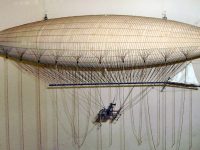Gaetano Crocco – Italian Aerospace Pioneer
On October 26, 1877, Italian aviation pioneer Gaetano Arturo Crocco was born. He was the founder of the Italian Rocket Society, and went on to become Italy’s leading space scientist. As head of the School of Aeronautics of the University of Rome, he performed research on flight mechanics, structural design, and high altitude flight in addition to his work in rocket propulsion. Gaetano Crocco – Early Years Crocco was the son of a…
Read more











